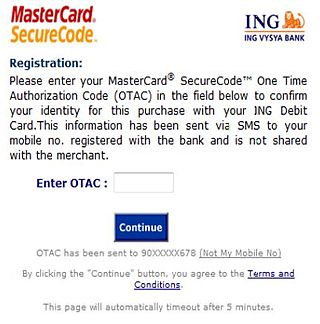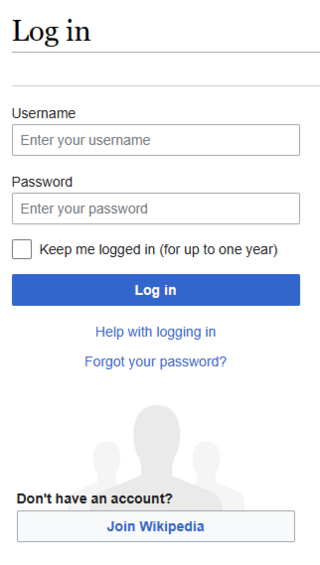Kerberos is a computer-network authentication protocol that works on the basis of tickets to allow nodes communicating over a non-secure network to prove their identity to one another in a secure manner. Its designers aimed it primarily at a client–server model, and it provides mutual authentication—both the user and the server verify each other's identity. Kerberos protocol messages are protected against eavesdropping and replay attacks.
Remote Authentication Dial-In User Service (RADIUS) is a networking protocol that provides centralized authentication, authorization, and accounting (AAA) management for users who connect and use a network service. RADIUS was developed by Livingston Enterprises in 1991 as an access server authentication and accounting protocol. It was later brought into IEEE 802 and IETF standards.
RSA SecurID, formerly referred to as SecurID, is a mechanism developed by RSA for performing two-factor authentication for a user to a network resource.
S/KEY is a one-time password system developed for authentication to Unix-like operating systems, especially from dumb terminals or untrusted public computers on which one does not want to type a long-term password. A user's real password is combined in an offline device with a short set of characters and a decrementing counter to form a single-use password. Because each password is only used once, they are useless to password sniffers.
Single sign-on (SSO) is an authentication scheme that allows a user to log in with a single ID to any of several related, yet independent, software systems.

A one-time password (OTP), also known as a one-time PIN, one-time authorization code (OTAC) or dynamic password, is a password that is valid for only one login session or transaction, on a computer system or other digital device. OTPs avoid several shortcomings that are associated with traditional (static) password-based authentication; a number of implementations also incorporate two-factor authentication by ensuring that the one-time password requires access to something a person has as well as something a person knows.

A security token is a peripheral device used to gain access to an electronically restricted resource. The token is used in addition to, or in place of, a password. It acts like an electronic key to access something. Examples of security tokens include wireless keycards used to open locked doors, or a banking token used as a digital authenticator for signing in to online banking, or signing a transaction such as a wire transfer.
In the context of an HTTP transaction, basic access authentication is a method for an HTTP user agent to provide a user name and password when making a request. In basic HTTP authentication, a request contains a header field in the form of Authorization: Basic <credentials>, where credentials is the Base64 encoding of ID and password joined by a single colon :.
Extensible Authentication Protocol (EAP) is an authentication framework frequently used in network and internet connections. It is defined in RFC 3748, which made RFC 2284 obsolete, and is updated by RFC 5247. EAP is an authentication framework for providing the transport and usage of material and parameters generated by EAP methods. There are many methods defined by RFCs, and a number of vendor-specific methods and new proposals exist. EAP is not a wire protocol; instead it only defines the information from the interface and the formats. Each protocol that uses EAP defines a way to encapsulate by the user EAP messages within that protocol's messages.
Mutual authentication or two-way authentication refers to two parties authenticating each other at the same time in an authentication protocol. It is a default mode of authentication in some protocols and optional in others (TLS).
In cryptography, CRAM-MD5 is a challenge–response authentication mechanism (CRAM) based on the HMAC-MD5 algorithm. As one of the mechanisms supported by the Simple Authentication and Security Layer (SASL), it is often used in email software as part of SMTP Authentication and for the authentication of POP and IMAP users, as well as in applications implementing LDAP, XMPP, BEEP, and other protocols.
In a Windows network, NT LAN Manager (NTLM) is a suite of Microsoft security protocols intended to provide authentication, integrity, and confidentiality to users. NTLM is the successor to the authentication protocol in Microsoft LAN Manager (LANMAN), an older Microsoft product. The NTLM protocol suite is implemented in a Security Support Provider, which combines the LAN Manager authentication protocol, NTLMv1, NTLMv2 and NTLM2 Session protocols in a single package. Whether these protocols are used or can be used on a system which is governed by Group Policy settings, for which different versions of Windows have different default settings.
Data Protection Application Programming Interface (DPAPI) is a simple cryptographic application programming interface available as a built-in component in Windows 2000 and later versions of Microsoft Windows operating systems. In theory, the Data Protection API can enable symmetric encryption of any kind of data; in practice, its primary use in the Windows operating system is to perform symmetric encryption of asymmetric private keys, using a user or system secret as a significant contribution of entropy. A detailed analysis of DPAPI inner-workings was published in 2011 by Bursztein et al.
Electronic authentication is the process of establishing confidence in user identities electronically presented to an information system. Digital authentication, or e-authentication, may be used synonymously when referring to the authentication process that confirms or certifies a person's identity and works. When used in conjunction with an electronic signature, it can provide evidence of whether data received has been tampered with after being signed by its original sender. Electronic authentication can reduce the risk of fraud and identity theft by verifying that a person is who they say they are when performing transactions online.

In computer security, logging in is the process by which an individual gains access to a computer system by identifying and authenticating themselves. The user credentials are typically some form of username and a matching password, and these credentials themselves are sometimes referred to as alogin. In practice, modern secure systems often require a second factor such as email or SMS confirmation for extra security. Social login allows a user to use existing user credentials from a social networking service to sign in to or create an account on a new website.
SAP Logon Tickets represent user credentials in SAP systems. When enabled, users can access multiple SAP applications and services through SAP GUI and web browsers without further username and password inputs from the user. SAP Logon Tickets can also be a vehicle for enabling single sign-on across SAP boundaries; in some cases, logon tickets can be used to authenticate into 3rd party applications such as Microsoft-based web applications.

Google Authenticator is a software-based authenticator by Google. It implements multi-factor authentication services using the time-based one-time password and HMAC-based one-time password, for authenticating users of software applications.

The FIDOAlliance is an open industry association launched in February 2013 whose stated mission is to develop and promote authentication standards that "help reduce the world’s over-reliance on passwords". FIDO addresses the lack of interoperability among devices that use strong authentication and reduces the problems users face creating and remembering multiple usernames and passwords.
Web Authentication (WebAuthn) is a web standard published by the World Wide Web Consortium (W3C). WebAuthn is a core component of the FIDO2 Project under the guidance of the FIDO Alliance. The goal of the project is to standardize an interface for authenticating users to web-based applications and services using public-key cryptography. WebAuthn credentials are sometimes referred to as passkeys.
Passwordless authentication is an authentication method in which a user can log in to a computer system without the entering a password or any other knowledge-based secret. In most common implementations users are asked to enter their public identifier and then complete the authentication process by providing a secure proof of identity through a registered device or token.




